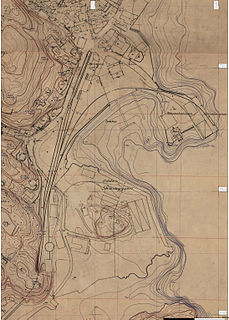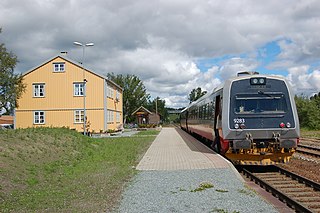Related Research Articles

The Røros Line is a 383-kilometer (238 mi) railway line which runs through the districts of Hedmarken, Østerdalen and Gauldalen in Innlandet and Trøndelag, Norway. The line branches off from the Dovre Line at Hamar Station and runs a more easterly route to Støren Station, where the two lines meet again. The Røros Line also intersects with the Solør Line at Elverum Station. The single track, standard gauge line lacks electrification and only has centralized traffic control south of Røros Station. The Norwegian State Railways (Vy) operate regional passenger trains. In addition the line is used by freight trains hauling lumber and wood chippings.

The Dovre Line is a Norwegian railway line with three slightly different lines which all lead to the historic city of Trondheim.

The Nordland Line is a 729-kilometer (453 mi) railway line between Trondheim and Bodø, Norway. It is the longest in Norway and lacks electrification. The route runs through the counties of Trøndelag and Nordland, carrying a combination of commuter, long-haul passenger and freight trains. From Trondheim Central Station to Steinkjer Station the line is most heavily used, with hourly services by the Trøndelag Commuter Rail. There are three branch lines—the Stavne–Leangen Line at Leangen Station, the Meråker Line at Hell Station and the Namsos Line at Grong Station.

The Arendal Line is a 45-kilometer (28 mi) long railway line between Arendal and Simonstad in Norway. At Nelaug, 37 kilometers (23 mi) north of Arendal, the line intersects with the Sørland Line. The southern section is electrified and provides a feeder passenger service. The line originally ran 90 kilometers (56 mi) north from Arendal to Treungen and the lake Nisser, but the upper-most part has been removed. The line is owned by the Norwegian Railway Directorate and operated by Go-Ahead Norge using Class 69 trains.

The Meråker Line is a 72-kilometer (45 mi) railway line which runs through the district and valley of Stjørdalen in Trøndelag county, Norway. The line branches off from the Nordland Line at Hell Station and runs eastwards to the Norway–Sweden border, with Storlien Station acting as the border station. From there, the line continues as the Central Line. Traditionally, the Meråker Line was regarded as the whole line from Trondheim Central Station to the border, a distance of 102 kilometers (63 mi). There are two daily passenger train services operated by the Norwegian State Railways and a limited number of freight trains hauling lumber and wood chippings.

Carl Abraham Pihl was a Norwegian civil engineer and director of the Norwegian State Railways (NSB) from 1865 until his death. Pihl was one of the main architects of the use of narrow-gauge railways in Norway.

The Gråkallen Line is an 8.8-kilometre (5.5 mi) suburban tram line located in Trondheim, Norway. As the only remaining part of the Trondheim Tramway, it runs from the city centre at St. Olav's Gate, via the suburban area Byåsen to Lian. It is designated Line 9, and is served by six Class 8 articulated trams. After the closure of the Arkhangelsk tramway in 2004, it became the world's northernmost tramway system.

The Grimstad Line was a 22-kilometer (14 mi) long railway line between Grimstad and Rise in Norway. The line was a branch of the Arendal Line, which is in turn a branch of the Sørland Line. Opened as the Grimstad–Froland Line on 14 September 1907, it was originally a private railway. The line was nationalized and taken over by the Norwegian State Railways in 1912. The railway was originally built with 1,067 mm narrow gauge, but was converted to standard gauge in 1936. Because of the cumbersome transfers, the line had few passenger and little freight. It was closed and demolished in 1961.

Trondheim Central Station or Trondheim S is the main railway station serving the city of Trondheim, Norway. Located at Brattøra in the north part of the city centre, it is the terminus of the Dovre Line, running southwards, and the Nordland Line, which runs north. The railway is electrified south of the station but not north of it, so through trains must change locomotives at the station.

The Stavne–Leangen Line is a 5.8-kilometer (3.6 mi) railway line between Stavne and Leangen in Trondheim, Norway. The line provides an alternative connection between the Dovre Line and Nordland Line, allowing trains to bypass Trondheim Central Station. The line includes the Stavne Bridge over the river of Nidelva, Lerkendal Station and the 2.7-kilometer (1.7 mi) long Tyholt Tunnel. Construction of the line started during the Second World War by the Wehrmacht, the German military occupying Norway, in an attempt to make the railway in Trondheim resistant to sabotage. Because of the long construction time of the tunnel, tracks were laid in the city streets, but neither route was completed before the end of the war. Construction was placed on hold and the Stavne–Leangen Line did not open until 2 June 1957. At first it was primarily used by freight trains. Since 1988, passenger services from the Dovre Line to Lerkendal Station have been provided, but they do not use the Tyholt Tunnel, instead taking a U-turn back across the Nidelva onto the Dovre Line.

The Solør Line is a 93.6-kilometer (58.2 mi) railway line that runs through district of Solør in Innlandet county, Norway. The line connects the Kongsvinger Line at Kongsvinger Station with the Røros Line at Elverum Station, running through the municipalities of Kongsvinger, Grue, Åsnes, Våler and Elverum. The standard gauge line lacks electrification and centralized traffic control; it is solely used by freight trains, mostly hauling lumber and wood chippings.

The Trøndelag Commuter Rail is a commuter train service operating in Trøndelag county, Norway. It was operated by Vy with Class 92 diesel multiple units, until 7 June 2020 when SJ Norge took over the contract until 2030. The service provides a commuter service connecting Trondheim to its suburbs, between towns in Innherred and as an airport rail link for Trondheim Airport, Værnes. Although passenger services have operated along the lines since 1864, the commuter train was created with an increase of service with existing rolling stock in 1993. In 2019, the system was used by 1.4 million passengers.

Hamar Station is a railway station of the Dovre Line and the Røros Line located in downtown Hamar, Norway. Located 126.26 kilometers (78.45 mi) from Oslo Central Station, it is served by long-distance and regional trains on the Dovre Line, as the terminus for regional trains on the Røros Line. All trains are operated by SJ Norge, except the regional trains between Lillehammer and Oslo, which are operated by Vy. A side platform and an island platform are in regular use. The station handled 1,062,300 passengers in 2008.

The Dunderland Line was a 23.7 km (14.7 mi) railway line between Gullsmedvik in the town of Mo i Rana and the village of Storforshei in Rana Municipality in Nordland county, Norway. Since 1942 the line has been part of the Nordland Line. The line was originally built and owned by Dunderland Iron Ore Company, which used it to freight iron ore from their mine at Storforshei to the port at Gullsmedvik.

The Hell–Sunnan Line is a 105-kilometer-long (65 mi) railway line between Hell, Stjørdal and Sunnan, Steinkjer in Nord-Trøndelag, Norway. The name is no longer in official use and the line is now considered part of the Nordland Line. The Hell–Sunnan Line branches from the Meråker Line at Hell and runs on the east shore of the Trondheimsfjord passing through the municipalities of Stjørdal, Levanger, Verdal, Inderøy and Steinkjer.

Heimdal Station is a railway station located in Heimdal in Trondheim, Norway. Located 12 km south of Trondheim Central Station on the Dovre Line, it is served by express trains between Trondheim and Oslo Central Station as well as the regional train services Trøndelag Commuter Rail and Nabotåget, all operated by SJ Norge. The station is staffed.

The Norwegian railway network consists of 2,552 kilometers (1,586 mi) of electrified railway lines, constituting 62% of the Norwegian National Rail Administration's 4,114 kilometers (2,556 mi) of line. The first three mainline systems to be electrified were private ore-hauling lines. The Thamshavn Line opened in 1909, and remained in revenue use until 1973, after which it was converted to a heritage railway. It is the world's oldest remaining alternating-current railway and the only narrow gauge railway in the country to have been electrified. It was followed by Norsk Transport's Rjukan and Tinnoset Lines two years later, and Sydvaranger's Kirkenes–Bjørnevatn Line in 1922. The Norwegian State Railways' (NSB) first electrification was parts of the Drammen Line in 1922 and the ore-hauling Ofoten Line in 1923, which connects to the Iron Ore Line in Sweden. The use of El 1 locomotives on the Drammen Line proved a large cost-saver over steam locomotives, and NSB started electrifying other lines around Oslo; from 1927 to 1930, the remainder of the Drammen Line, and the continuation along the Randsfjorden and Sørlandet Lines to Kongsvinger were converted, along with the first section of the Trunk Line. In 1935, the Hardanger Line became the first section of new NSB track to be electrified. From 1936 to 1940, NSB electrified the Østfold Line as well as more of the Sørland Line and the Bratsberg Line, connecting all electric lines west of Oslo.

Mære Station was a railway station on the Nordland Line at the village of Mære in the municipality of Steinkjer in Trøndelag, Norway. The station opened on 1 April 1917 and closed on 7 January 2001.
Gulfoss Tunnel is a 701-meter (2,300 ft) railway tunnel situated in the municipality of Melhus in Trøndelag county, Norway. The tunnel runs beneath the village of Hovin, alongside the river Gaula past the Gulfossen waterfall. The tunnel carries a single, electrified track of the Dovrebanen railway line. The Trondhjem–Støren Line, which opened in 1864, crossed the river Gaula on a bridge to the opposite side of the river at the current site of the tunnel. This section of track was a challenge due to regular flooding. With the 1908 decision to build the Dovrebanen Line and gauge conversion, the Gulfossen section became one of two parts of the line to be reworked. Gulfoss Tunnel opened on 6 July 1918.
References
- ↑ Kjenstad, Rune (1994). På skinner i Bymarka. Baneforlaget. p. 19. ISBN 82-91448-01-9.
- ↑ "Flåmsbana". Sogn og Fjordane County Encyclopedia (in Norwegian). Norwegian Broadcasting Corporation. Retrieved 19 January 2009.